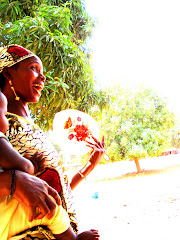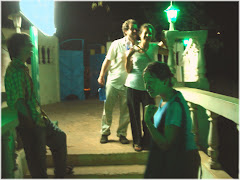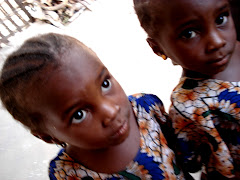I’m back from village for a few days in Kombo but I’m leaving tomorrow morning for Guinea. This will be my first real vacation since coming here unless you count Dakar which was more of an extended weekend. I will be gone for a week. I’m going with several Peace Corps friends, some of whom came when I did and a few who have been here longer. Tara, Ted, Mai, Natasha, Tyler, Cassandra, and Alex. We will leave from Kombo tomorrow morning, cross the River Gambia at Barra, and then take overland transport for about nine hours to Basse. From there we will begin the thirty hour overland trek through Senegal and into Guinea. We want to stay in a small village near Labe’ where we are told that we can wander through mountain ranges and swim in waterfalls. Many Volunteers from here have gone there and it is highly recommended.
We will be there for a week and then I will be back to work. I’m going to conduct a few beekeeping trainings on my trek back to Barra from Basse on the North Bank. The National Beekeeper’s Association of The Gambia (NBAG) was awarded a grant from a UK based charity called Feed the Minds with which we are trying to reach 400 rural people to encourage beekeeping. We want to stress the advantages of traditional methods while promoting modern management techniques. We will discuss the woven grass hive and the wooden Kenyan Top Bar (KTB) hive, talk about pests and diseases, and demonstrate honey harvesting and wax rendering. We will make three such visits to each training site over the course of the next nine months so that we can focus on seasonal training. The first classes will talk about baiting hives and apiary locations, the second will focus on harvesting honey and managing brood, the third will look at project development and advanced methods.
I have also spent a fair amount of time these past few weeks working with bees at the NBAG apiary near Brikama. There we have about twenty colonies which are giving us a lot of opportunities to learn and to develop our management strategy. We have baited several hives with beeswax to attract colonies. The technique we use is to run a thin bead of melted wax along the center of about half of the top bars in a KTB. Field bees from feral colonies find these baited hives and when they swarm (anytime between September and January in The Gambia) hopefully they will relocate to our apiary. This method of “bait and wait” is a very popular way to colonize hives here. I do not know anyone who is involved in queen rearing or hive splitting and so I am exploring these methods as part of my primary work at NBAG. If we can develop a method that improves beekeepers’ access to bees, we can begin to really promote sustainable beekeeping here.
One problem that we have with our KTB hives here is that bees do not understand our management strategy. Though we would like them to build one comb per top bar so that we can manage each comb individually, they rarely do this. Often they” cross-comb” so that combs are positioned diagonally and are therefore attached to three or four top bars. This makes brood management and honey harvest very difficult and creates a major obstacle for proactive beekeeping. We are developing a technique of cutting the comb from top bars and then repositioning it onto each individual top bar using narrow gauge wire. We tried cloth strips but found that bees didn’t like the intrusion of that material and would abandon entire combs. The wire method has been more successful and if it continues to work we will incorporate the strategy into our rural training modules.
Back in village, it is harvest-time. We ended up having much too much rain this year and so our maize crops were almost a complete failure. Gambians look forward all of hungry-season to the first ears roasted on open fires but sadly this year gave us few opportunities to enjoy that night-time treat. On the flipside though, the rain was great for our rice, millet, sorghum, and groundnut crops. Last year my host family brought in about 19 bundles of millet while this year we have 31and are still harvesting. The Nerica rice that I planted looks terrific and I expect a good harvest in another two weeks or so. I planted about four kilos and will harvest probably 25-30 which I will save as next year’s seed.
But looking at the crops around my village has keyed me in on something that I cannot hide from. The last few years have been unseasonably dry and so people have blamed crop failures on the lack of precipitation. But this year saw plenty of rain and still crops haven’t yielded as much as we had hoped. Subsistence farmers here have limited time to grow enough food for the entire year plus we should be able to put away enough for seed Many plants are stunted and yield is low across the country. The soils are depleted and it is difficult to do anything about it. Chemical fertilizer is transient in the soil and expensive and so does not provide a sustainable solution to fertility issues. Fallowing is easier said than done: For fallowing to work, land has to be uncultivated for up to twenty years but people are unable to rotate fields to such a degree that this would be possible. Agroforestry techniques such as alley cropping and green manure crops take a long time to be successful, require protection from grazing animals, and often need supplemental care to get them through the dry season. I cannot see how to make enough compost to improve the soil of these huge fields.
One technique that I am experimenting with at my village is the use of bio-char as a soil amendment. Basically, bio-char is slash from trees and crop residues (millet stalks, rice hulls, and groundnut shells) burnt in a reduced oxygen environment to create a fine-grained charred substance that retains up to 50% of the pre-burn biomass. It is made similarly to charcoal production but that practice is illegal in The Gambia. The law aside, many people have clandestine charcoal operations in the bush around my village. The technique, called pyrolysis, involves stacking biomass, covering it with soil, and then setting it afire. It smolders for several weeks until the charcoal-makers uncover it and then sell the fist-sized pieces on the open-market for low-smoke cooking purposes. They leave behind a large pile of fine-grained charred substance that I scavenge from the bush and take to my demonstration garden in my village. I add it to my compost or put it directly into garden soils.
Bio-char produces long-lasting results that can be present in the soil for thousands of years. The burned biomass increases potassium (the K in NPK) and stabilizes nitrogen (the N) to prevent leaching. It improves soil tilth and increases microbial populations. The bio-char creates a habitat where wee-beasties can thrive by increasing humidity and improving soil respiration. The addition of bio-char to the earth provides the carbon component of the micro-organisms’ diet with the added benefit of being not rapidly consumed. In field studies, where bio-char is combined with either organic or inorganic fertilizers, the vegetative growth and grain production was significantly improved over plots where NPK was used without bio-char.
So, as you can see, I am staying busy here. I really love the work that I do and enjoy the place where I do it. I have approached the country director for PCTG about applying for an extension of my service. He was enthusiastic but told me that budget-cuts within Peace Corps have made such extensions difficult. The new rules are that the Volunteer can only apply for an extension on the same continent as he is already serving and that to be considered he has to be willing to serve for an additional two years. Previously if a Volunteer extended she could serve for one additional year and could go to almost any country for which she was qualified. Still, I want to look at my options and will write my letter of intention when I return from Guinea so that my CD can begin the paperwork.
Another thing that has kept me busy is planning for my parents’ trip to The Gambia. They will be coming for two weeks in December. I salute them. Many Volunteers have told me that their families have expressed no interest in coming to visit. Sure, things here are tough, but I think we will have a terrific time. We will spend some time in Dakar before coming to The Gambia. Here, we plan to relax along the beach in Sanyang, visit my village up-country, and perhaps take a boat trip out to a small island where there is a chimpanzee rehabilitation program.
Let me take this opportunity to apologize that this blog post has no photographs. I left my digital camera at site. I was so distracted with wrapping-up projects and packing for the next three weeks away from village that I forgot that my camera was in my bike-bag where it still resides. Funny thing though: When I packed my bag for Guinea I decided that I would take my 35mm SLR camera with me because I want to get back into taking high-quality film pictures instead of the point-and-shoot type that I have been taking since coming here. So I will. Don’t fret though, there will be plenty of digital cameras on this trip and so I will try to post some of the pictures that my traveling companions take on my next blog.
Sorry also that this blog is so technical. I hope that it is not boring to read about the work that I’m doing. Usually I try to be entertaining in these missives but I’ve been so busy that I don’t really have funny little anecdotes about life here. No snakes this time. In addition to all the work that I mentioned above, I have written two long articles for our AgFo newsletter, worked on writing a grant to the UNDP for my queen-rearing program, updated our beekeeping manual, and started to prepare for the technical training of the new trainees that arrive here next month. All this said, Guinea Take Me Away.
Talk to you when I get back. I hope that you have peace.
Minh-Tam and Me in Fuladu


Swarm in Kolli Kunda

Blocks and Bull, Foni Jarrol

Palm and hut, Fajara

Boys in Foni Jarrol

Artist's rendition of a lagoon near Gunjur

Beekeeper, Lower Niumi

On the Bintang Bolong, Foni Jarrol

The Jabang Family and Me, Sifoe

Minh-Tam's Bad Hair Day

Tapping for Palm Wine, Sanyang

Advice to Toubobs, Dakar, Senegal

In Kiang, bushfire behind me

Roasting Groundnuts

Queen Rearing

Clowns in Foni Jarrol, The Gambia

Sarjo and Aminata in Foni Bondali, The Gambia

Jeff, Kat, Tyler, and Amber at the Green Mamba

Hawa and Adama

Friends oceanside, The Gambia

At the Abuko Nature Preserve, The Gambia Western Division

The Atlantic from Fajara, The Gambia

They don't call them killer bees for nothing

Girl with balloon in Kiang District, The Gambia

Baobab tree in Kiang District, The Gambia

My host father Baa Sanna Jallow making rope from baobab bark

Steps in Arch 22, Banjul, The Gambia

Small boy, big snake in Western Region, The Gambia

Bakary pouring attaya, Kiang Region The Gambia

Happy times, Kiang Region The Gambia

My house, Foni Jarrol The Gambia
Friends pages from The Gambia
About Me

- Matthew Traucht
- I was born and raised in farm-country Ohio but didn't really acquire my green thumb until I moved to New Mexico in 1998 and started gardening. I graduated from high school in 1991 and attended classes at Kent State where I studied philosophy. I took a few years off to pursue other interests and then majored in cultural anthropology at the University of New Mexico. I started a small organic farm and sold produce at growers markets and called my business "A Growing Sense." In September 2007 I moved to The Gambia where I am an Agroforestry Volunteer with the United States Peace Corps.
It is always a mistake to try to explain plans for an onward journey. Such plans sound meaningless because they are so presumptuous. Travel at its best is accidental, and you can't explain improvisation.
-Paul Theroux Dark Star Safari
-Paul Theroux Dark Star Safari
















